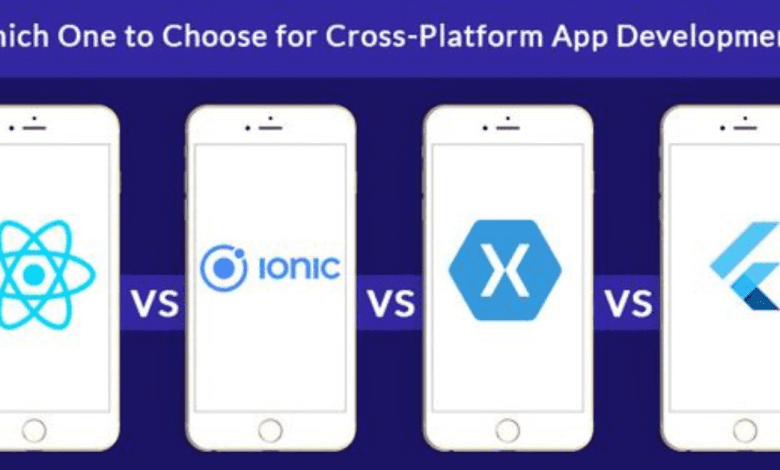Platforms Of Development
Get To Know About The Next King Of Cross Platform

Who Is The King of Cross-Platform App Frameworks, Flutter Or React Native?
There can be no doubt that cross platforms app development enables businesses to quickly access a larger audience. The total cost of creating an app from scratch as well as the price of providing support will be kept to a minimum.
It will take less time to plan, create, test, and launch the app if you can create only one app instead of two separate ones for different platforms. On the other hand, the code used for cross-platform apps is always reusable, which means that the developers’ code can be utilised for numerous app projects and the iOS and Android platforms.
The cost to create a Flutter app or a React Native app is always less than that of a native app because of reusable code. In addition, cross-platform development frameworks keep improving by adding native UI components and becoming more adept at imitating the behaviour of native OS platforms.
React Native and Flutter are the two technologies that have the most competitive in the world of app development. A Flutter development business has discovered that the framework is more effective for quick native and multi-platform UI development.
Despite React Native’s longstanding reign as the uncontested monarch of cross-platform app development. Now let’s evaluate the merits and limitations of these two apps and find out why the top mobile app development company work with the latest technologies.
Flutter’s Benefits & Drawbacks
Flutter is a powerful UI development toolkit that can be used to create both iOS and Android app frontends with similar success. When it threaten React Native’s hegemony in cross-platform development in 2017, it generated a lot of buzz. Flutter, however, offers an equal mix of benefits and drawbacks despite all the commotion, media coverage, and popularity it attracted.
Pros
Flutter is the most potent and complete cross-platform development framework with everything a project needs, and it leads the pack in terms of app performance. Flutter promises significantly quicker development because it provides a wide variety of pre-built UI widgets and toolkits.
In contrast to previous cross-platform frameworks, Flutter’s apps may operate on desktop and web platforms in addition to mobile OS platforms like iOS and Android. With its modular approach to development, Flutter ensures MVP-style incremental development.
Both the Firebase backend and the Android Studio IDE offer dual support for Flutter apps. Flutter employs Dart, an object-oriented, functional language with clean and lean coding that has a little environmental impact. To assist developers in assessing app performance right away after making code changes, Flutter provides a hot reload capability.
Cons
Flutter is only allowing to use of 20% or less native code, unlike other cross-platform frameworks like React Native. Despite Dart’s small footprint and abundance of widgets, Flutter can sometimes cause app performance to suffer. This increases the framework’s size.
It may take some time for new developers to become acquainted with Dart because it is still not as well-known as JavaScript. Since Flutter first enter the development scene in 2017, it still lacks the backing of a strong developer community.
Benefits & Drawbacks Of React Native
React Native, which first enter the development landscape in 2014, has since emerged as the preferred solution for developers working on all types of mobile app projects, especially those that require simultaneous release on both the iOS and Android platforms.
In essence, the React Native development framework is a UI library that can be used to create apps for all platforms. The framework offers a similar number of benefits and drawbacks despite its amazing capabilities and capacity to build apps more quickly and affordably. Many people go for a mobile app for their busniesses.
Pros
React Native enables developers to reuse up to 85% of the codebase across platforms, resulting in blazingly quick development results. For both the iOS and Android mobile OS platforms, React Native may connect with the native or platform-specific UI layers to create a genuinely native user experience.
For creating iOS and Android apps, React Native has a sizable and potent library of pre-built templates and components. The main language of React Native, JavaScript, emerges as the most well-liked and establish technology, guaranteeing a very short and manageable learning curve.
Over the years, React Native has been employed in a variety of app projects by top commercial companies, and it has enormous and unrivalled community support. To assist with app testing, React Native also offers a large selection of debugging and testing tools. React Native’s hot reload feature enables developers to instantly assess code changes, which speeds up app maintenance and upgrades.
Cons
React Native is still a UI library, hence it lacks substantial framework-like guidelines to aid developers in their work. React Native app projects demand solid native development skills because, depending on the app’s nature and feature set, they may need to manage up to 20% to 30% native code.
A bridge is required for React Native to communicate with the native UI layer. This might slow down the app’s performance and development rate. Now that we have a basic understanding of the fundamental advantages and disadvantages of the React Native and Flutter frameworks, it is crucial to contrast these two tools in light of significant app development domains. Let’s start.
Computer Language
Dart is a wholly unorthodox programming language that is used by Flutter. JavaScript, a widely used and respected coding language, is used in React Native. React Native has the ability to runtime compile dynamic JavaScript code to the native app’s UI layer.
The remaining code can be compiled and executed by the app’s virtual machine. The coding style used by Dart, a general-purpose programming language, is concise and clear. The language has features that work well in both online and mobile apps, among other app kinds.
Architecture
There are advantages and disadvantages to both of these frameworks’ architectural approaches. Flutter employs Dart, a programming language that offers data architectural features like abstraction, inheritance, encapsulation, and polymorphism.
Flutter communicates with the native layer using the Dart bridge architecture, which guarantees faster performance. The architecture of React Native is Flux, which offers MVC model properties. The fact that Flutter enables unidirectional data flow is just another fantastic feature. Multiple companies are masters in the architecture of the frameworks.
API For UI Component Development
Both provide a great selection of UI components and APIs that are ready for usage. React Native significantly relies on third-party libraries to access native UI modules. As it comes pre-load with a wide variety of components for native modules, Flutter fully eliminates the need for any third-party libraries.
Performance Of The Developers
React Native appears to have an advantage in terms of productivity and ease of development. Because JavaScript is supported by all IDEs, React Native offers developers more freedom and convenience. Dart, which is used by Flutter, is supported by a few IDEs and text editing programs. For some developers, this can make things challenging and less adaptable.
Community Assistance
React Native was initially introduced and has been the most popular framework for many years. On all development platforms, it has a sizable community, as can be expected. Despite being later, Flutter quickly gains notoriety and appeal, and it currently boasts a fast-expanding developer community.
App Evaluation
Regarding app testing, there are key distinctions between these two technologies. For app development, React Native mainly relies on third-party integration and testing technologies. Unit tests, widget tests, and integration tests are just a few of the three testing tiers that Flutter offers out of the box.
Automation Of Development & Deployment
React Native is less effective than Flutter for automated development and deployment. Since React Native doesn’t include instructions for automated platform deployment, developers must figure things out on their own. On the other hand, Flutter offers ready deployment support through CLI and includes thorough documentation to aid developers in the deployment process.
Support For DevOps & CI/CD
For app projects, the DevOps methodology, Continuous Integration (CI), and Continuous Development (CD) methodologies are growing in popularity. In terms of supporting these methods, Flutter clearly outperforms React Native. There is no official documentation offered by React Native for configuring the CI/CD of app projects. Flutter provides a distinct manual for CI and app testing. It’s also extremely simple to make the same configuration using Flutter CLI.
Conclusion
It is evident from the comparison that both Flutter and React Native have fantastic advantages of their own. The distinctions are only relevant if you plan to construct a certain kind of software. Each performs best when use for the right software project in its own unique way.
There are different and multiple mobile app development packages that can be found on the internet. Today there are many platforms available for mobile app development for instance Magento 2 Mobile App Builder, WordPress Mobile App Tool and many more.





